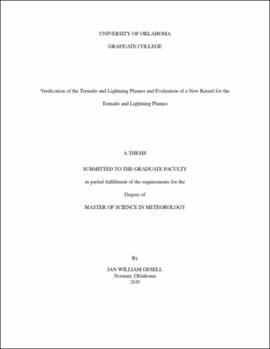| dc.description.abstract | Though tornado forecasts have been of interest much longer, the National Weather Service (NWS) has been issuing tornado alerts and warnings for more than 50 years. On 1 October 2007, the NWS began issuing storm-based warnings. However, surveys, assessments, and evaluations following the 26-28 April 2011 southeast tornado outbreak and the 22 May 2011 Joplin, MO tornado noted the desire for additional information and communication outside of the watch/warning paradigm. Due to this, and other issues with storm-based warnings, Forecasting a Continuum of Environmental Threats (FACETs) was proposed. FACETs is a framework that could modify the current watch/warning system to communicate hazardous weather information to serve the public. A key part of FACETs is Probabilistic Hazard Information (PHI). Currently warnings are yes/no (binary); they have a start and end time, but do not provide a likelihood of the event or a time of arrival or departure. PHI changes this by putting threat probabilities onto grids that are updated as the storm moves.
PHI plumes for tornado, lightning, wind, and hail were created by NWS forecasters as part of experiments in the NOAA Hazardous Weather Testbed (HWT) in 2016 and 2017. These probabilistic plumes were produced using the storm size and speed to determine the width and length of the plumes. A Gaussian smoother from the center point was then used to provide a visualization of the forecast threat area and region of uncertainty in the HWT.
Since these forecasts are probabilistic, a method of forecast verification is needed to determine the accuracy of these plumes instead of binary verification. Currently, the NWS verifies warnings in this binary nature if a severe local storm report is in the warning. However, most probabilistic forecasts are not verified in this manner. For example, the Storm Prediction Center verifies outlooks with a correct forecast corresponding to an event occurring within 25 mi (40 km) of a forecast point. To move away from the deterministic verification of warnings, this study first examines event distances for both lightning and tornado hazards, and then applies verification methods used for other probabilistic forecasts to define an appropriate reference class.
Lightning and tornado hazards were chosen for this study since the verification for each of these are the most reliable. The verification data used for the lightning plumes was the National Lightning Detection Network. The tornado plumes were verified by tracking the mesocyclone coordinates using start and end time from the Storm Events Database or using tornado warnings.
This study uses four different tornado and lightning cases from the 2017 HWT PHI experiment. First, for a case the PHI tool code was run to regenerate all the plumes for tornado and lightning hazards from the forecasters. Then, all the plumes for a given time step were merged together spatially. Next, the maximum probability of the plumes at all time steps for a case were merged together and saved producing an accumulation plot. Attributes and ROC diagrams were created for the forecaster data. Practically perfect plumes were then created for comparison to the forecaster PHI to better understand what an ideal forecast could be following the same forecasting constraints and/or rules.
Multiple thresholds of distance (i.e, 0.5 km - 7.5 km) were used to determine the appropriate neighborhood or definition of ``an event'' for the probabilistic hazard. For each of the tornado and lightning cases, it was found that using a 7.5 km radial distance away from the mesocyclone coordinates or the NLDN flashes, as a neighborhood where the event was defined, was where the attributes diagrams indicated the plumes were most accurate. Practically perfect plumes were used in addition to the forecaster plumes to evaluate the tornado and lightning plumes for an ideal forecast.
Epanechnikov, Quartic, and Triangular kernels were applied to the forecaster and practically perfect created probabilities to see if there was a better kernel than Gaussian for either of the tornado or lightning plumes. It was found that for the tornado plumes the Gaussian kernel provided the best results. However, for lightning the Epanechnikov kernel was the best kernel to use to apply to the probabilities. | en_US |
